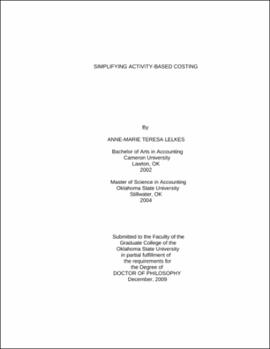| dc.contributor.advisor | Hansen, Don R. | |
| dc.contributor.author | Lelkes, Anne-Marie Teresa | |
| dc.date.accessioned | 2013-11-26T08:31:16Z | |
| dc.date.available | 2013-11-26T08:31:16Z | |
| dc.date.issued | 2009-12 | |
| dc.identifier.uri | https://hdl.handle.net/11244/7139 | |
| dc.description.abstract | Scope and Method of Study: This study first analyzes the conditions under which Time-Driven Activity-Based Costing (TDABC) is equivalent to Activity-Based Costing (ABC). When these equivalency conditions do not hold, there is error. Accordingly, this study also analyzes the maximum absolute percentage error of TDABC that can occur when the equivalency conditions do not hold. However, even when the equivalency conditions are satisfied, TDABC can provide inaccurate costing results when resource diversity exists. Because of the potential resource diversity issue of TDABC, this study provides a new simplified ABC system (TDABC2) that overcomes the limitations of both ABC and TDABC. The equivalency conditions for TDABC2 relative to ABC are analyzed mathematically as well as the maximum absolute percentage error, which occurs when the equivalency conditions for TDABC2 do not hold. Finally, case studies containing data from a particular company are used as an initial analysis to provide anecdotal evidence of the validity of the equivalency conditions. | |
| dc.description.abstract | Findings and Conclusions: This study shows analytically that TDABC2 is a viable and simpler alternative to the ABC and TDABC systems currently in practice. The two major benefits of TDABC2 are that Stage 1 has been eliminated and Stage 2 has been greatly simplified. Since only the total cost, total time, the unit cycle time, and the number of units of the cost object that will be produced need to be known, the cost to implement the system should be, obviously, significantly lower than that of ABC, perhaps as low as that of the functional-based system. Since TDABC2 has been analytically proven to be as accurate as ABC under certain conditions, there should be typically no significant tradeoff between the benefit of accuracy and the cost of the system. Hence, TDABC2 should be of great benefit to practitioners who want a relatively accurate, low-cost, and easy to implement costing system. | |
| dc.format | application/pdf | |
| dc.language | en_US | |
| dc.rights | Copyright is held by the author who has granted the Oklahoma State University Library the non-exclusive right to share this material in its institutional repository. Contact Digital Library Services at lib-dls@okstate.edu or 405-744-9161 for the permission policy on the use, reproduction or distribution of this material. | |
| dc.title | Simplifying activity-based costing | |
| dc.contributor.committeeMember | Cornell, Robert M. | |
| dc.contributor.committeeMember | Currier, Kevin M. | |
| dc.contributor.committeeMember | Wetzel, Thomas S. | |
| osu.filename | Lelkes_okstate_0664D_10555.pdf | |
| osu.accesstype | Open Access | |
| dc.type.genre | Dissertation | |
| dc.type.material | Text | |
| dc.subject.keywords | abc | |
| dc.subject.keywords | activity-based | |
| dc.subject.keywords | costing | |
| dc.subject.keywords | simplifying | |
| dc.subject.keywords | tdabc | |
| dc.subject.keywords | time-driven | |
| thesis.degree.discipline | Accounting | |
| thesis.degree.grantor | Oklahoma State University | |
